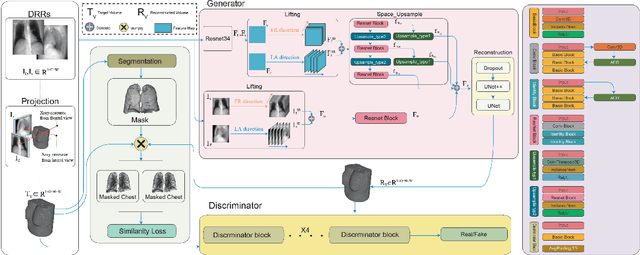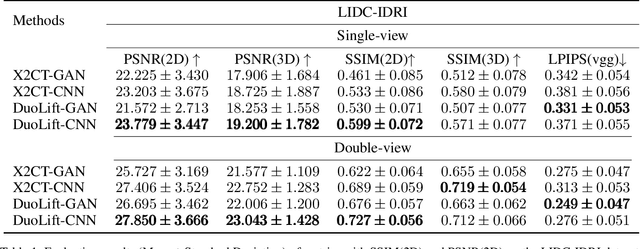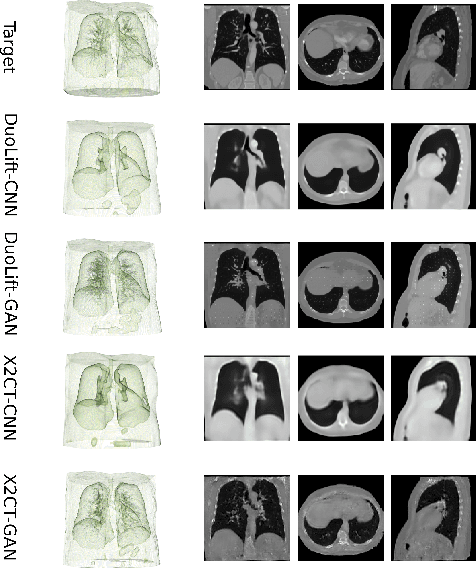Yueliang Ying
DuoLift-GAN:Reconstructing CT from Single-view and Biplanar X-Rays with Generative Adversarial Networks
Nov 12, 2024



Abstract:Computed tomography (CT) provides highly detailed three-dimensional (3D) medical images but is costly, time-consuming, and often inaccessible in intraoperative settings (Organization et al. 2011). Recent advancements have explored reconstructing 3D chest volumes from sparse 2D X-rays, such as single-view or orthogonal double-view images. However, current models tend to process 2D images in a planar manner, prioritizing visual realism over structural accuracy. In this work, we introduce DuoLift Generative Adversarial Networks (DuoLift-GAN), a novel architecture with dual branches that independently elevate 2D images and their features into 3D representations. These 3D outputs are merged into a unified 3D feature map and decoded into a complete 3D chest volume, enabling richer 3D information capture. We also present a masked loss function that directs reconstruction towards critical anatomical regions, improving structural accuracy and visual quality. This paper demonstrates that DuoLift-GAN significantly enhances reconstruction accuracy while achieving superior visual realism compared to existing methods.
MHRC: Closed-loop Decentralized Multi-Heterogeneous Robot Collaboration with Large Language Models
Sep 25, 2024



Abstract:The integration of large language models (LLMs) with robotics has significantly advanced robots' abilities in perception, cognition, and task planning. The use of natural language interfaces offers a unified approach for expressing the capability differences of heterogeneous robots, facilitating communication between them, and enabling seamless task allocation and collaboration. Currently, the utilization of LLMs to achieve decentralized multi-heterogeneous robot collaborative tasks remains an under-explored area of research. In this paper, we introduce a novel framework that utilizes LLMs to achieve decentralized collaboration among multiple heterogeneous robots. Our framework supports three robot categories, mobile robots, manipulation robots, and mobile manipulation robots, working together to complete tasks such as exploration, transportation, and organization. We developed a rich set of textual feedback mechanisms and chain-of-thought (CoT) prompts to enhance task planning efficiency and overall system performance. The mobile manipulation robot can adjust its base position flexibly, ensuring optimal conditions for grasping tasks. The manipulation robot can comprehend task requirements, seek assistance when necessary, and handle objects appropriately. Meanwhile, the mobile robot can explore the environment extensively, map object locations, and communicate this information to the mobile manipulation robot, thus improving task execution efficiency. We evaluated the framework using PyBullet, creating scenarios with three different room layouts and three distinct operational tasks. We tested various LLM models and conducted ablation studies to assess the contributions of different modules. The experimental results confirm the effectiveness and necessity of our proposed framework.
 Add to Chrome
Add to Chrome Add to Firefox
Add to Firefox Add to Edge
Add to Edge